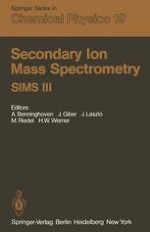1982 | OriginalPaper | Chapter
Secondary Ion Mass Spectrometry of Organic Compounds; A Comparison with Other Methods (EI, CI, FI, FD, FAB)
Author : K. D. Klöppel
Published in: Secondary Ion Mass Spectrometry SIMS III
Publisher: Springer Berlin Heidelberg
Included in: Professional Book Archive
Activate our intelligent search to find suitable subject content or patents.
Select sections of text to find matching patents with Artificial Intelligence. powered by
Select sections of text to find additional relevant content using AI-assisted search. powered by
In recent years secondary ion mass spectrometry (SIMS) has attained an increasing importance for the detection of organic compounds deposited on solid surfaces. In the static SIMS-method very low primary ion current densities are used in order to minimize the extent of fragmentation of the organic compounds deposited on metallic surfaces [1,2]. However, relatively fragment-free mass spectra of organic compounds have been also obtained applying high primary ion current densities [3,4]. A definite advantage of these secondary ionization (SI) techniques over more conventional ionization methods, like electron impact (EI), chemical ionization (CI), and field ionization (FI) lies in the fact that evaporation of the organic sample prior to analysis is not necessary. In this respect SI resembles the field desorption technique (FD) and many thus be preferentially applicable to the structure elucidation of organic salts and other labile, non—volatile compounds. Fragmentation patterns and ion intensities obtained by SI are, however, more readily controlled by varying parameters, such as current density, energy, and kind of primary ions, as well as nature and pretreatment of the target material. It has been shown that intensive cationic molecular ions are obtained by adding alkali halides to the organic target material [2,5].
